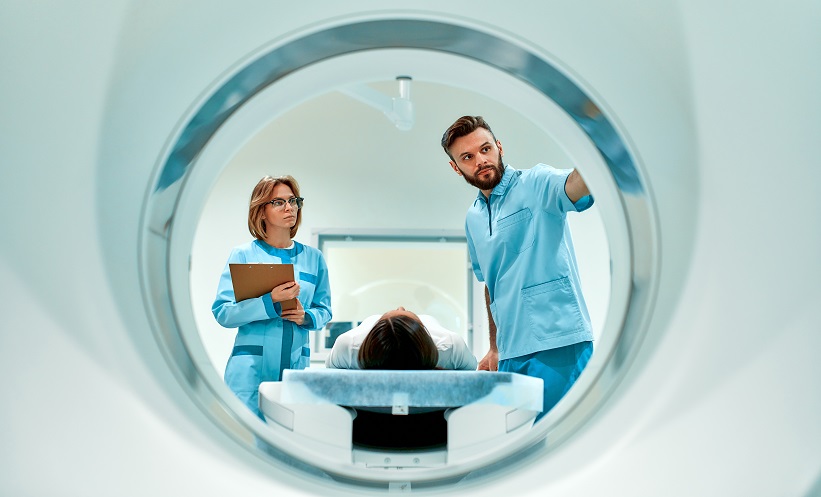Author: Darcy Richards, Editorial Assistant
Citation:EMJ Radiol. 2022;3[1]:18-22. DOI/10.33590/emjradiol/10030701. https://doi.org/10.33590/emjradiol/10030701.
![]()
DETECTING cancer at an early stage is a multi-faceted challenge for clinicians. Screening programmes aid identification of disease before symptoms arise, when prognosis is likely to be better. However, several barriers affect implementation, uptake, and delivery of these programmes. A session on the early detection and diagnosis of lung and prostate cancer, and the role of radiologists, took place at this year’s hybrid European Congress of Radiology (ECR) 2022 in Vienna, Austria, 13th–17th July. The session provided expert discussion on the importance of lung and prostate cancer screening programmes; the role of radiologists in screening programme guidelines, early detection, and diagnosis; the challenges associated with population-based screening; and hopes for the future.
THE ROLE OF RADIOLOGISTS IN SCREEENING
Screening guidelines are a crucial element for evidence-based management. From contributing to guidelines to analysing and reporting scans, the role of the radiologist is imperative for accurate diagnosis to enable appropriate subsequent management. Caro Franck, Antwerp University Hospital (UZA), University of Antwerp, Belgium, highlighted how “lung cancer is a public health issue” and that diagnosis is often made at a late stage when curative treatment is not possible, resulting in high mortality. As an example of their role in screening programmes, Franck noted the importance of radiologists working alongside medical physicists to develop low-dose CT protocols for cancer screening and highlighted the crucial role in reading the scans.
THE IMPORTANCE OF EARLY DETECTION
The experts at the ECR 2002 session agreed that early detection is key to improving outcomes for patients with lung and prostate cancer, as population-based screening programmes save lives by improving rates of cancer detection prior to metastasis.
Erik Briers, Patient Advocate, Hasselt, Belgium, and member of the European Society of Radiology (ESR) Patient Advisory Group, highlighted how risk-stratified, population-based screening can lead to early detection of prostate cancer, and that active surveillance should be standard care for those deemed low-risk following initial serum prostate-specific antigen (PSA) screening to enable prompt action if PSA rises.
Anne-Marie Baird, Trinity College, Dublin, Ireland, and President of Lung Cancer Europe (LuCE), added to this, highlighting that lung cancer accounts for almost 20% of cancer-associated mortality in Europe. Baird noted that “currently, the majority of people are diagnosed with late-stage disease,” which emphasises the necessity for early screening programmes in the at-risk population to enable early diagnosis when prognosis is better.
Further to this, Briers highlighted that since free PSA testing for males >50 years in Belgium was discontinued in 2010, the number of prostate cancer diagnoses and deaths have risen. Briers stated that >50% of prostate cancers are picked up at higher stages (Stages II–IV), rather than at early stage (Stage I). These findings highlight the value of early screening in identifying cancer at an earlier stage, for better patient outcomes across a larger group of patients.
BARRIERS TO SCREENING AND EARLY DIAGNOSIS
Lack of awareness, distance to facilities, cost and infrastructure, access, symptom normalisation, pre-conceived beliefs about screening, resource limitations, funding, and fear are some of the barriers that impede early cancer screening.
Access to hospitals or facilities limits participation in screening programmes. A UK study found that one of the main reasons to decline participation was the travel distance from their home to the hospital. One way in which this could be overcome is the use of mobile CT units. Baird highlighted how access to accurate diagnostics improves outcomes through better-informed treatment plans, which ultimately improves quality of life for patients.
AWARENESS, INFRASTRUCTURE, AND FUTURE INNOVATIONS
To improve the delivery of screening programmes, the session speakers noted a need to increase awareness of cancer screening programmes. Briers highlighted that “awareness of prostate cancer is extremely important; prostate cancer is something that you need to know about to be motivated to go for a very simple screening test;” while Baird stated that “there is a lack of public awareness” surrounding lung cancer screening.
Franck discussed how data from existing screening programmes and epidemiological studies have shown the benefit of low-dose CT screening in those deemed at high-risk for lung cancer. The NLST (USA) and the NELSON (Belgium and the Netherlands) trials have both shown “a reduction in lung cancer-specific mortality with low-dose CT.” Other European trials such as LUSI (Germany), MILD (Italy), and UKLS (UK) have shown similar results. Despite this evidence, uptake into screening programmes is low. Franck stated that one way in which this could be improved is for radiologists to have “a more visible role” in public education on imaging-based cancer screening.
One of the concerns considered with imaging-based screening programmes is exposure to radiation through imaging techniques. Franck highlighted the role of medical physicists and radiologists in developing low-dose CT protocols for lung cancer screening to balance achieving optimal image quality with the lowest dose of radiation possible. This prevents the need for repeat scans secondary to poor image quality, reducing radiation exposure and risk of radiation-induced malignancy.
Franck spotlighted further innovations, including how the use of artificial intelligence-based computer-aided detection (CAD) software could revolutionise reading of lung cancer screening images. Upon the CAD of a nodule, the scan would be forwarded to a radiologist for verification; however, if there is no CAD of a nodule, no further action would be required. This could greatly reduce the increased workload that an imaging-based screening programme roll-out would generate for radiologists.
Looking forward, the ‘Europe’s Beating Cancer Plan’ has been announced. There is hope that this will include screening programme outlines for multiple different cancers, including lung and prostate cancers, and provide a roadmap to facilitate roll-out across different member states.
PANEL DISCUSSION: QUESTIONS FOR THE EXPERTS
How Do False Negatives from Serum Prostate Specific Antigen Affect Screening?
Briers noted that there were “very few” false negatives; however, certain subtypes of prostate cancer, such as neuro-endocrine prostate cancer, do not cause elevated PSA and, therefore, patients can have low PSA levels despite metastasised cancer. This highlights that although screening aims to improve detection rates and, ultimately, patient outcome, it will not catch all prostate cancers.
Was Cost Considered When Analysing Priority Settings and Resource Limitations in Research Conducted by Lung Cancer Europe?
Baird shared that cost-effectiveness was not included in the questionnaire as it was targeting those living with the disease or in a care-giving capacity and their understanding of lung cancer screening. Baird commented that, as given screening is for those who are at high-risk but asymptomatic, these patients would likely accept delays in access because of the comfort in being involved in a screening programme where patients are being monitored.
How Can Infrastructure Be Improved to Increase the Pace of Screening and Patient Prioritisation?
The experts discussed how hospitals would need to recruit additional radiologists to read the scans from lung cancer screenings and re-emphasised the potential role for CAD to reduce the burden of scans to review by clearing the negative scans. Franck highlighted how resource requirement calculators can help plan accurate and adequate resource distribution.
Briers noted that to detect and curatively treat early-stage prostate cancer costs approximately 10,000 EUR; however, to treat metastasised prostate cancer the cost can range 200,000–500,000 EUR per patient. This should be considered in the cost evaluation for screening programmes. Briers further added that not every patient will be invited to imaging and not all those invited will attend. For prostate cancer, only individuals with a PSA above a certain cut-off should be included at initial screening; for lung cancer screening, it should be those deemed high risk (e.g., those with a heavy smoking history).
CONCLUSION
This ECR 2022 session highlighted the key role of radiologists in improving early cancer detection via screening programmes. Expert input from multidisciplinary professionals to develop effective screening programmes for early cancer detection is imperative to improving public health. Ensuring adequate awareness, infrastructure, and accessibility will be key in implementing these necessary programmes. With advances in radiology, artificial intelligence, and patient advocacy, and in light of Europe’s Beating Cancer Plan, rates of early detection and diagnosis could increase to ultimately provide treatment at earlier stages, when prognosis is better.








